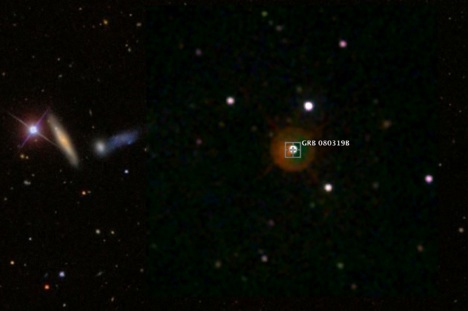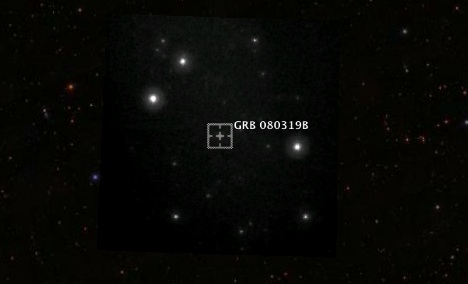In his work, Arthur C. Clarke often employed pathos to contrast the human scale against the immense scale of the universe. When he once mused on TV that the Star of Bethlehem had in fact been a supernova, now pulsar PSR 1913+16B, he added:
How romantic, if even now, we can hear the dying voice of a star which heralded the Christian era.
Clarke was also not averse to using electromagnetic bursts as plot devices for his fiction. We all know what happens if you dig up a monolith on the moon…
How romantic, then, to think that within hours of Clarke’s death in Sri Lanka on March 19, an exquisitely timed salute flashed past Earth in the form of a massive gamma ray burst, GRB 080319B, by far the most luminous ever recorded. It was even briefly visible to the naked eye despite having travelled 7.5 billion light-years. That points to a stunningly powerful explosion. NASA provides more context:
GRB 080319B’s optical afterglow was 2.5 million times more luminous than the most luminous supernova ever recorded, making it the most intrinsically bright object ever observed by humans in the universe. The most distant previous object that could have been seen by the naked eye is the nearby galaxy M33, a relatively short 2.9 million light-years from Earth.
Why was it so powerful? Phil Plait at Bad Astronomy blog suggests it’s because one of the twin jets of the explosion may have pointed straight at us:
And why was this one so frakkin’ bright? Was it a more energetic explosion itself, or were we, by coincidence, looking precisely down the center of the beam? If the beam of a GRB is pointed ever-so-slightly away from us, so that the edge nicks us, the GRB will look fainter. By staring down the throat of a GRB we’d see it as bright as it could possibly be. Maybe GRB080319B had us dead in its sights.
Clarke, a famous atheist, would never have mistaken a coincidence to be a meaningful event, but surely he too would have smiled at an alignment between his life, the Earth’s current location in the universe and an event that occurred half-way back to the big bang.
Here’s a series of time-lapse observations that show the burst occurring (check out frame 97-98), courtesy of the real-time data processing team “Pi of the sky”. NASA’s Swift satellite took a higher resolution image showing visible light.

Both the Pi and the Swift images are available online, though no-one has turned them into a KML overlay for a more immersive view. Viewed by themselves in isolation, it is hard to get a sense of the scale involved; anchored onto Google Sky, it all comes together. Notice UGC 9350 nearby?
So I made this KMZ file. It contains a highly accurate placemark for GRB 080319B as well as two positioned overlays, from “Pi of the sky” and Swift. It helps to turn on and off each layer in turn, and also play with the opacity slider.

Here’s hoping that both scientists and mainstream media start supplying these kinds of overlays as an integral part of their output. Arthur C. Clarke would approve — it adds pathos:-)
[Update 20:17 UTC: on March 21, Larry Session suggested the burst be called the Clarke Event.]
One of the best Posts in this Blog here..
I agree!
Damn it people!!!!! They have been seen more often and brighter than u think!! March 14th or 15 2005.Tremendous…bright as full moon at its furthest out.About half the size.Orange/yellow like the sun.Not blinding.Full view.Pulsated for approx 5-6 secs duration.Then collapse at a speed that was unreal.It was a sick experience.Seen from Southern Asia 3:30 a.m.The pulsating was phenominal in and of itself.The collapse left me in awe.Thought I was going insane.Records?? Haven’t found any.Not much time to look either.But I was blessed to have probably been one of a handfull of westerners to view if any.cmfranklin70@yahoo.com